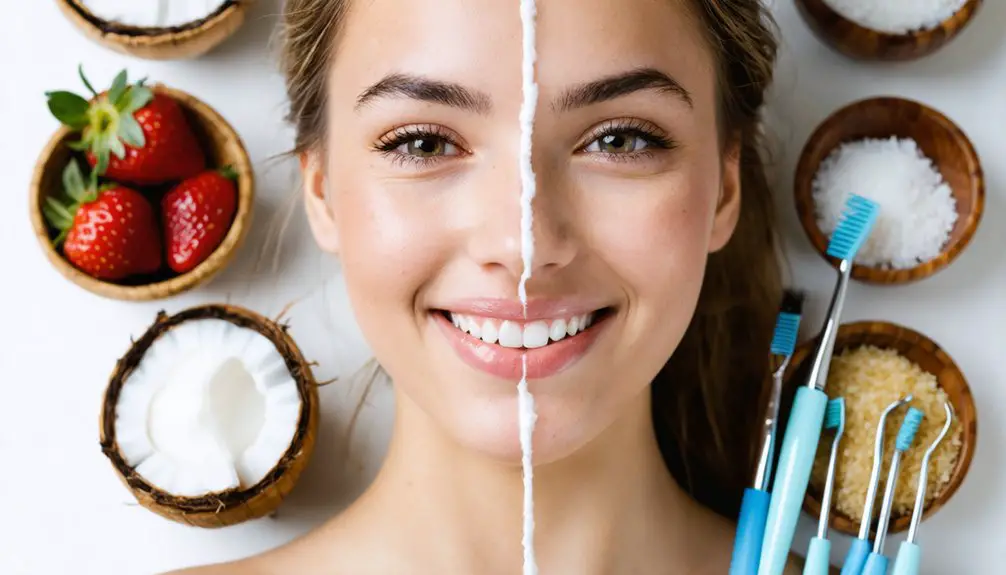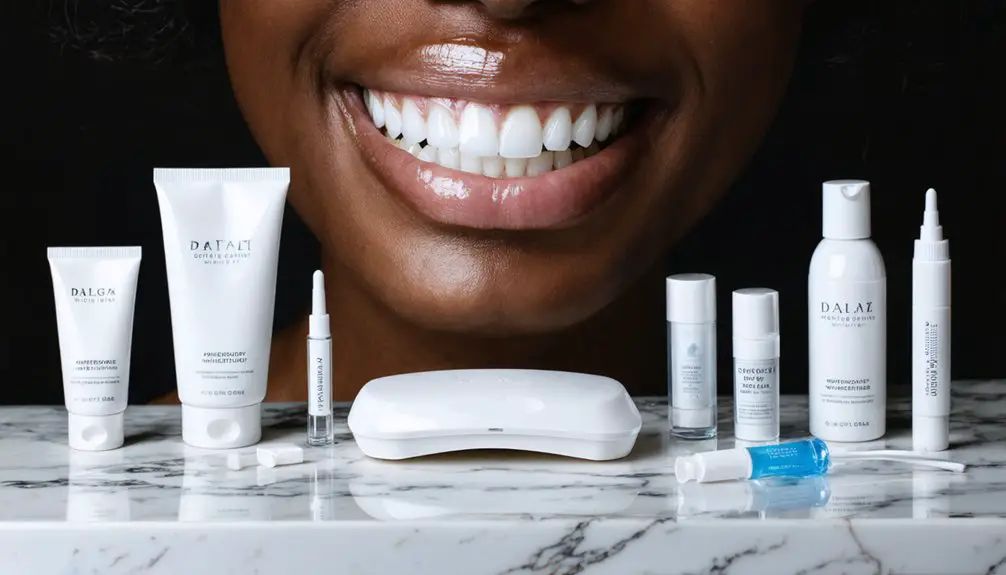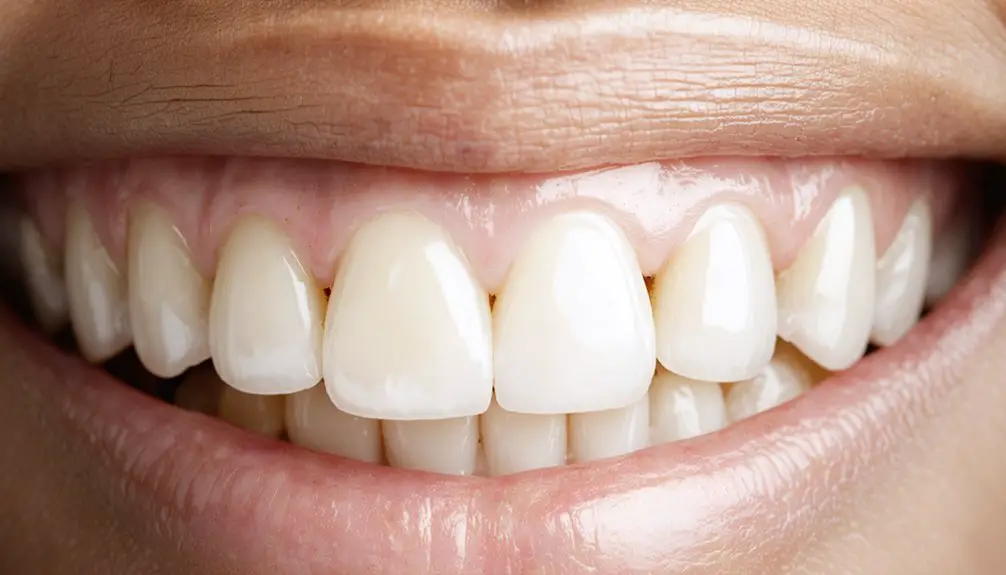You’ll achieve a dazzling smile through a combination of professional treatments and proven at-home methods. Start with a dental consultation to determine the best whitening approach for your teeth. Use FDA-approved products with appropriate peroxide concentrations, and maintain consistent oral hygiene practices. Consider professional LED or laser treatments for dramatic results, or try custom-fitted trays for gradual improvement. The path to your brightest smile includes essential techniques and expert guidance beyond basic whitening.
Key Takeaways
- Brush thoroughly twice daily with fluoride toothpaste and floss regularly to maintain optimal oral hygiene and prevent staining.
- Consider professional teeth whitening treatments for dramatic results, offering up to 8 shades lighter in a single session.
- Avoid staining substances like coffee, tea, and red wine immediately after whitening treatments to preserve results.
- Schedule regular dental cleanings every six months to maintain oral health and keep your smile bright.
- Use FDA-approved whitening products and consult a dentist before starting any whitening regimen for safe, effective results.
Understanding Professional Teeth Whitening Options
Five distinct professional teeth whitening options offer superior results compared to over-the-counter treatments.
Professional methods utilize higher concentrations of bleaching agents, delivering up to 8 shade improvements in a single session. The typical cost of these treatments ranges from $350 to $1,200.
With professional-grade bleaching concentrations, your smile can transform dramatically – up to 8 shades whiter in just one treatment.
Professional tray systems offer custom-fitted applications you can use at home, achieving noticeable results within days.
You’ll find laser treatments that activate whitening agents in about 60 minutes, while LED activation systems provide customizable intensity levels for ideal results in 90-minute sessions. The latest advancements ensure safer tissue protection during laser procedures.
For those seeking flexibility, professional tray systems offer custom-fitted applications you can use at home, achieving noticeable results within days.
All professional options emphasize sensitivity management through protective barriers and expert supervision.
Whether you choose Zoom whitening’s instant results or combine treatments for enhanced longevity, you’ll benefit from dentist-supervised procedures that guarantee safety and effectiveness, with results lasting 1-3 years under proper maintenance.
At-Home Whitening Methods That Actually Work
While professional treatments offer dramatic results, several at-home whitening methods can effectively brighten your smile when used correctly. Over-the-counter kits containing hydrogen peroxide or carbamide peroxide deliver noticeable results within two weeks when used consistently. Individual results depend on your natural tooth color, as the yellow hue of dentin affects whitening outcomes. Whitening agents work by breaking down chromogens that cause staining in teeth.
Gel-filled trays provide faster whitening than strips by maintaining longer contact with your teeth.
For those seeking natural whitening options, baking soda combined with hydrogen peroxide can remove surface stains when used once or twice weekly. However, exercise caution with effective DIY methods, as overuse can damage tooth enamel.
While coconut oil pulling supports oral health, it won’t greatly whiten teeth. For best results, choose evidence-based approaches like peroxide-based products, follow application instructions carefully, and maintain good oral hygiene to preserve your whitening results.
The Science Behind Effective Teeth Bleaching
Understanding the molecular chemistry behind teeth whitening reveals why certain bleaching methods produce superior results. When you apply bleaching agents containing hydrogen peroxide or carbamide peroxide, they initiate an oxidation process that penetrates your tooth structure.
These compounds break down into reactive species that target both surface and deep-set stains. The effectiveness of your whitening treatment depends on several factors: peroxide concentration, chemical stability, and treatment duration. This process typically takes five to fifteen minutes for the whitening gel to fully penetrate the tooth.
Peroxide-based whiteners penetrate deeply, breaking down stubborn stains through controlled chemical reactions that depend on concentration and exposure time.
As these agents seep through your enamel’s microscopic channels, they break down complex stain molecules into smaller, colorless compounds. While maintaining enamel integrity, the whitening process occurs three-dimensionally throughout your tooth layers. The process requires careful monitoring of pH levels above 5.5 to prevent demineralization of tooth enamel.
Professional treatments may use light activation to enhance penetration while preserving your tooth’s mineral structure, ensuring safe and predictable stain removal.
Managing Sensitivity During Whitening Treatment
Managing tooth sensitivity effectively is essential for a successful whitening treatment.
You’ll want to start with a professional dental evaluation to identify any underlying issues that could increase discomfort. Implementing sensitivity reduction strategies before treatment, such as using desensitizing toothpaste containing potassium nitrate or fluoride for 1-2 weeks, can greatly improve your comfort level. Taking regular breaks between treatments allows your teeth’s enamel to recover and maintain its strength. A soft-bristled toothbrush is recommended for gentle cleaning to avoid aggravating sensitivity.
During treatment, focus on patient comfort techniques like choosing lower peroxide concentrations and spacing out your whitening sessions.
You’ll need to avoid hot, cold, and acidic foods for 48 hours post-treatment.
Consider professional whitening services, as dentists can customize treatments and incorporate desensitizing agents.
If you’re using at-home kits, select products specifically designed for sensitive teeth and follow the manufacturer’s instructions carefully to prevent prolonged sensitivity.
Daily Habits That Keep Your Smile Bright
While you’re working to maintain your bright smile, it’s crucial to avoid staining foods and beverages like coffee, tea, and red wine immediately after whitening treatments.
You’ll need to establish a consistent brushing routine of two minutes, twice daily, using fluoride toothpaste to remove plaque and prevent discoloration.
Regular visits to dental professionals here will ensure your whitening efforts stay on track. Incorporating crunchy fresh produce into your diet can naturally help clean teeth while you eat. Combining these practices with daily flossing will help preserve your teeth’s whiteness while supporting long-term oral health.
Avoid Staining Foods First
To maintain a radiant smile, you’ll need to carefully navigate the daily minefield of staining substances in your diet. Start by identifying the major culprits: dark berries, beets, and tomato-based sauces contain powerful pigments that readily adhere to teeth.
Coffee, tea, and red wine are particularly problematic due to their high tannin content, which helps staining compounds bond to your enamel.
Watch out for the double threat of acidic beverages like citrus juices, sports drinks, and sodas. These not only contribute to enamel erosion but also create a rougher surface that makes your teeth more susceptible to staining.
When consuming these items, rinse your mouth with water immediately afterward, and wait 30 minutes before brushing to protect your weakened enamel from mechanical damage.
Consistent Brushing Habits Matter
Beyond watching what you eat and drink, establishing proper brushing habits forms the cornerstone of maintaining your bright smile.
You’ll need to brush at least twice daily for a minimum of two minutes each session to effectively remove plaque and prevent dental problems. Your brushing techniques matter as much as frequency – proper method guarantees thorough cleaning of all tooth surfaces and gum lines.
Don’t let brushing motivation waver, as inconsistent habits can lead to serious consequences. Research shows that irregular brushing increases your risk of cardiovascular issues and periodontal disease.
Make nighttime brushing a non-negotiable ritual, as it’s particularly vital for preventing overnight bacterial growth. While 69% of Americans brush twice daily, joining this group will greatly improve your oral health outcomes and help maintain that bright, healthy smile you desire.
Avoiding Common Whitening Mistakes
Achieving a whiter smile requires more than simply applying bleaching products – it demands careful attention to proper techniques and professional guidance.
To avoid common whitening myths and guarantee ideal results, you’ll need professional dental consultations before starting any whitening regimen.
- Don’t skip your dentist’s evaluation – they’ll identify underlying issues like decay or sensitivity that could impact your whitening success.
- Address existing dental problems first – untreated conditions can lead to uneven results or increased discomfort.
- Follow product instructions carefully – overuse of whitening products can permanently damage your enamel.
- Secure full-mouth coverage – whitening only visible teeth creates noticeable color inconsistencies that detract from your smile.
Natural Remedies vs. Clinical Treatments

While natural whitening remedies like activated charcoal and baking soda can remove surface stains, clinical treatments with peroxide-based agents deliver more reliable and scientifically validated results for both surface and deep staining.
You’ll need to weigh the trade-offs between gentler home remedies that work gradually and professional treatments that offer faster, more dramatic results but may cause increased sensitivity.
Whether you choose natural or clinical approaches, it’s essential to follow proper protocols and avoid overuse that could damage your enamel or trigger prolonged tooth sensitivity.
Proven Clinical Results Matter
Scientific evidence consistently demonstrates the superior efficacy of clinical dental treatments compared to natural remedies.
When you’re choosing between treatment options, clinical success rates and treatment longevity data provide clear guidance. Professional dental interventions deliver measurable, evidence-based results that you can trust for your smile.
Here’s what research confirms about clinical dental treatments:
- Root canal treatments show 85% survival probability after 5 years
- Professional dental programs reduce decay by up to 27% in treated patients
- Clinical interventions increase dental attendance by 34% among children
- Dental therapist integration has expanded treatment capacity by 37%
These proven outcomes underscore why clinically-validated treatments remain the gold standard for achieving and maintaining ideal oral health.
Home Remedies: Worth It?
Natural remedies for teeth whitening have gained widespread popularity as cost-effective alternatives to clinical treatments, but their efficacy and safety profiles vary considerably.
While baking soda and hydrogen peroxide show promising DIY effectiveness when used properly, their frequent application can lead to enamel erosion and sensitivity.
You’ll need to approach natural whitening methods with caution. Oil pulling with coconut oil offers the safest daily option, though it won’t directly whiten teeth.
Safety concerns arise with acidic substances like lemon juice and abrasive materials such as activated charcoal, which can damage your enamel.
For best results without compromising dental health, limit baking soda and peroxide mixtures to twice weekly applications.
Remember that while natural remedies can enhance your smile, they typically don’t match the predictable outcomes of professional treatments.
Balancing Safety With Results
When choosing between natural remedies and clinical treatments for teeth whitening, understanding the risk-benefit profile becomes paramount.
While natural agents like baking soda offer mild whitening effects, clinical agents deliver more predictable and dramatic results. To achieve ideal outcomes while protecting your oral health, consider these evidence-based guidelines:
- Avoid acidic natural agents like lemon juice or vinegar, as they’ll erode your enamel irreversibly.
- Choose professional treatments with controlled peroxide concentrations for deeper, more uniform whitening.
- If using natural agents, limit application frequency and duration to prevent cumulative enamel damage.
- Monitor for sensitivity or gum irritation with any method, and discontinue use immediately if symptoms develop.
Selecting the Right Whitening Products

Looking to achieve that perfect white smile? When selecting whitening products, understanding key ingredients and application techniques makes all the difference.
Carbamide peroxide offers deeper, longer-lasting results than hydrogen peroxide alone, while professional-grade products deliver faster whitening effects.
Professional-strength carbamide peroxide penetrates deeper into tooth enamel for superior whitening results that last longer than standard hydrogen peroxide treatments.
For at-home treatments, whitening strips and custom-fit trays provide excellent tooth contact and reliable results. You’ll see the best outcomes with consistent application over 1-2 weeks.
LED-activated systems can intensify results when used 20-40 minutes daily, particularly with phthalimidoperoxycaproic acid formulations.
If you have sensitive teeth, choose products with lower peroxide concentrations and consider custom trays to minimize gum exposure.
While whitening toothpaste can help maintain results, it’s less effective for deep staining compared to dedicated whitening systems.
Long-Term Maintenance Strategies
Your daily oral hygiene routine forms the foundation of a lasting, beautiful smile, including thorough brushing with fluoride toothpaste and daily flossing to protect both natural teeth and cosmetic work.
You’ll need to schedule professional cleanings and check-ups every six months to remove stubborn buildup and catch potential issues before they compromise your smile’s appearance.
Regular monitoring by your dental team allows for personalized maintenance recommendations and timely interventions that will help preserve your investment in cosmetic dentistry for years to come.
Daily Habits Matter Most
Three fundamental habits form the cornerstone of maintaining a dazzling smile: consistent brushing, regular flossing, and proper tongue cleaning.
These daily oral hygiene practices guarantee thorough plaque removal and promote long-term dental health.
Your commitment to these essential practices will greatly influence your smile’s brilliance:
- Brush twice daily for 2-3 minutes using fluoride toothpaste and proper technique to remove surface bacteria.
- Clean between teeth daily with floss or interdental brushes to prevent plaque buildup in hard-to-reach areas.
- Include tongue cleaning in your routine to reduce bacteria and maintain fresh breath.
- Consider supplementing with an antimicrobial mouth rinse for enhanced protection.
Professional Care Schedule
While daily oral hygiene forms the foundation of dental health, professional dental care serves as a critical component in maintaining a dazzling smile long-term.
You’ll need to schedule dental cleanings every six months if you have good oral health, though your dentist may recommend more frequent visits based on your specific needs.
Professional cleaning frequency depends on factors like existing gum disease, diabetes, or osteoporosis, which might require visits every 3-4 months.
During these appointments, you’ll receive detailed plaque and tartar removal that brushing alone can’t achieve.
The dental exam importance can’t be overstated – these visits include oral cancer screenings, x-rays to detect hidden issues, and extensive evaluations of your gum health.
Safe and Healthy Whitening Practices
Achieving a brighter smile through teeth whitening requires careful attention to safety protocols and proven techniques. Following whitening regulations and ensuring product safety will help protect your dental health while delivering ideal results.
For the safest and most effective whitening experience:
- Choose FDA-approved products with appropriate peroxide concentrations – 3% for home use or up to 35% for professional treatments.
- Consult your dentist before starting any whitening regimen to evaluate your oral health and determine the best approach.
- Follow application instructions precisely and don’t exceed recommended treatment times to prevent enamel damage.
- Address sensitivity immediately by using fluoride products and taking breaks between treatments as needed.
Remember that proper technique and moderation are key to maintaining both the health and beauty of your smile.
Frequently Asked Questions
Can Teeth Whitening Affect Existing Dental Work Like Crowns or Veneers?
You won’t be able to whiten existing dental work like crowns or veneers. Teeth whitening only affects natural teeth, potentially creating a mismatch between your brightened teeth and unchanged restorations.
How Soon After Getting Braces Removed Can I Start Whitening Treatments?
You’ll want to wait six months after your beautiful smile emerges from braces before exploring whitening options. This post-braces care period guarantees your teeth are strong enough for safe, effective treatment.
Is It Safe to Whiten Teeth While Pregnant or Breastfeeding?
You shouldn’t whiten teeth during pregnancy or breastfeeding due to safety concerns. Instead, consider natural whitening alternatives like specialized toothpaste and maintain dental safety through regular cleanings and proper oral hygiene.
Why Do Some People’s Teeth Whiten Faster Than Others?
Your teeth’s whitening speed depends on genetic factors and enamel thickness, while surface stains respond quicker than deep discoloration. Natural tooth color and lifestyle habits also influence treatment effectiveness.
Can Medication-Stained Teeth Be Effectively Whitened With Standard Treatments?
Standard whitening methods don’t effectively remove deep medication stains, like tetracycline discoloration. You’ll need specialized whitening systems or cosmetic options like veneers for significant improvement of medication-stained teeth.
References
- https://www.alpinewhite.com/en/article/teeth-whitening-statistics/
- https://www.loudfamilydentistry.com/blog/teeth-whitening-related-statistics-on-effectiveness-and-sensitivity-incidence
- https://www.thedentalspajersey.com/blog/teeth-whitening-statistics-2024
- https://pmc.ncbi.nlm.nih.gov/articles/PMC4058574/
- https://pmc.ncbi.nlm.nih.gov/articles/PMC10024105/
- https://www.champaigndentalgroup.org/about-us/blog-articles/top-professional-teeth-whitening-techniques-2024-effective-safe
- https://www.veenstradental.com/blog/at-home-vs-professional-teeth-whiteningwhats-the-difference-
- https://lanedds.com/?p=26079
- https://www.arthurglosmandds.com/blog/different-methods-of-teeth-whitening/
- https://healthcare.utah.edu/the-scope/health-library/all/2023/10/does-home-teeth-whitening-really-work



